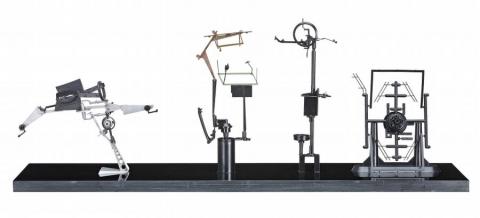NO. 362 (FOUR PLASTIC CONSTRUCTIONS), 1967-74
Robert Klippel
plastic machine parts, acrylic case
76.5 cm length
Richard Crebbin Collection, Sydney, acquired directly from the artist
Thence by descent
Private collection, Sydney
Gleeson, J., Robert Klippel, Bay Books, Sydney, 1983, pl. 308, pp. 362, 363, 410 (illus.)
Edwards, D., Robert Klippel: Catalogue raissoné of Sculpture , Art Gallery of New South Wales, Sydney, 2002, no. 362 (illus.)
With his singular vision, extraordinary inventiveness of form and unwavering dedication to his private quest for a spiritually relevant aesthetic, Robert Klippel stands alone in the annals of twentieth-century art as one of Australia's most intuitive and original sculptors. From the exquisite surrealist works of the 1940s to the energised junk sculptures of the 1960s, the delicate miniatures and lyrical works on paper to the monumental assemblages, his vast and extremely diverse oeuvre has consistently been inspired by the intricacies of both natural and built environments. Thus juxtaposing organic and mechanical, chance and intent, internal and external, science and religion, his art embodies not so much reconciliation or balance, but rather, as Deborah Edwards observes, 'the more subtle desire to forge a new, sometimes irrational, precarious, unforeseen and ultimately delicate equilibrium between his sense of a permanent order and the flux of the modern condition.'1
A spectacular example of the plastic constructions assembled from miniature machine parts which Klippel began during his second teaching sojourn at Minneapolis School of Art in 1967, NO. 362, 1967-75, encapsulates the artist's abiding preoccupation with plastic as a neutral material bearing few connotative qualities. As early as works such as NO. 64 Construction, 1954, Klippel had responded to the potential of plastic - excited not only by its transparency and apparent delicacy, but by its being uniquely of the present with no real art history or sculptural precedent. Yet where his previous forays had been spiky, nervous images of sculptural energy, the Minneapolis sculptures now became corporeal: a reversion to mass and volume, softer in their contours rather than utterly precise, flesh as opposed to skeleton and tendon.2 Significantly, these constructions also heralded a qualitative shift in junk, from the used and obsolete to the unused in toy and hardware stores. Indeed, perhaps motivated by the imminent birth of his son, in Minneapolis Klippel had created a form of miniature junkyard with thousands of parts from plastic kits for model machines, toy planes, cars, ships, tanks and fragments of children's plastic toys, the delight of which never wore off; as he later recalled, 'I'm flabbergasted by the unbelievable shapes and things you can find in these kits. I never cease to marvel at them = they're so brilliant.'3
Ever the independent, somewhat solitary creative spirit, it is perhaps no coincidence that Klippel embarked upon NO. 362 during a decade that saw the rise of the 'monumental' as the prevailing sculptural orthodoxy. Among the smallest works of his entire artistic oeuvre, such constructions thus reveal a highly idiosyncratic and intimate approach, attesting to the artist's unique and enduring appeal; as one critic observes, '...if his sculpture carries any sort of lesson it is both that important works of art will surely rise out of the present stream, and equally, that one doesn't necessarily have to be in it or with it in order to produce great works of art.'4
1. Edwards, D., Robert Klippel, Art Gallery of New South Wales, Sydney, 2002, p. 17
2. ibid., p. 108
3. Robert Klippel, Make it new: a profile of the sculptor Robert Klippel, documentary video produced by SBS in association with Don Featherstone Productions, 1992.
4. Thomas, L., 'Cogs and slats in a timeless Klippel - possibly only today', Australian, 8 February 1969.
VERONICA ANGELATOS
